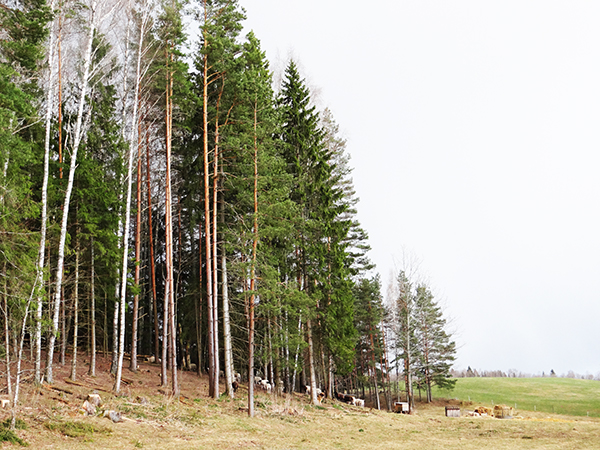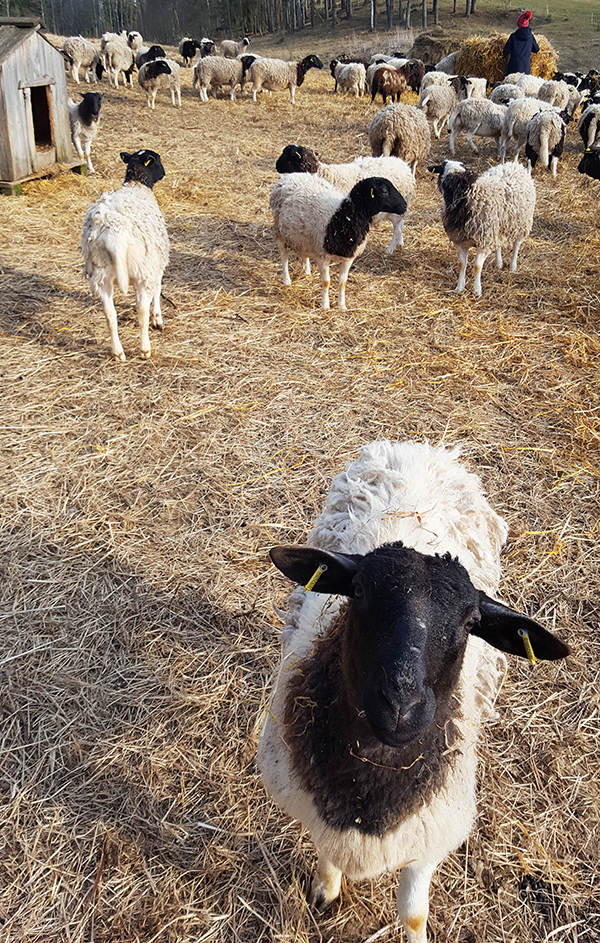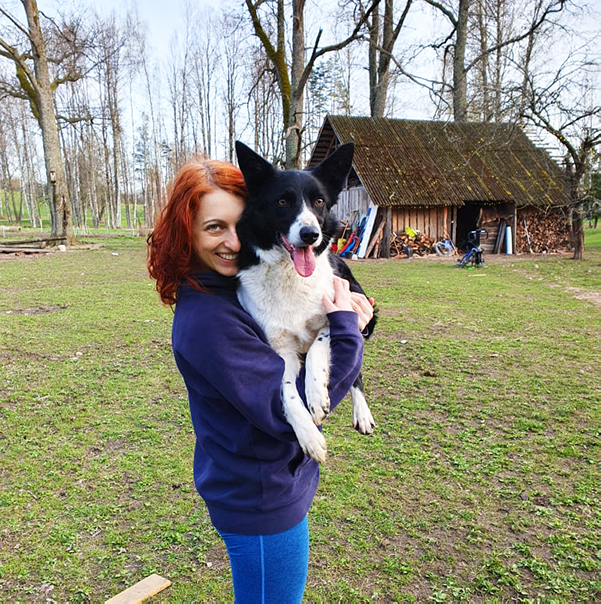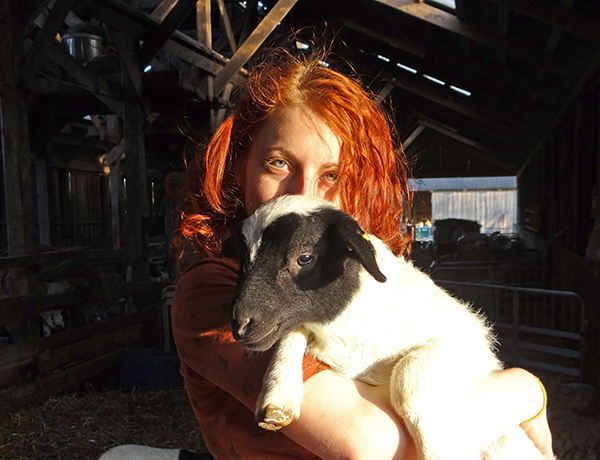This blog post was written by Marina, a Veterinary Medicine PhD student at the Estonian University of Life Sciences.

Karula in South Estonia. Photo: Marina
I was told that I will be doing my field work in the bear’s butt
Every language has a unique way of saying „in the middle of nowhere“, and in my case, the Estonian expression is perfectly fitting. I drive through the picturesque hills of Southern Estonia, storks flying by, a fox stopping to let me pass before she crosses the road, the birch trees stretching their naked branches into the blue sunny sky. There are so many lakes that when villages have names that include “saar”, I can actually believe that they are like islands in this watery landscape ("saar" means "island" in Estonian).
When the asphalt turns into gravel, I know I’m on the right road. Google Maps is no longer a big help, because the house I am headed to has no address. It is the house in the village where the Kuks family lives, that’s enough information. I know that I have to pass the modern house on the right; that the road should take another turn after the big lake... and then I have arrived. I am in the middle of Karula National Park. It’s one of those remote places in Estonia where the next neighbor lives a kilometer or two away, and reaching the nearest store takes a twenty minute drive. It’s “karu perses” – “in the bear’s butt”, which, as the National Park also contains the word “bear”, couldn’t describe it better.
I am glad that I chose a car with four-wheel-drive, and although there are days where I will run around in a t-shirt and with bare feet, it’s still April for most of my time here, and in Estonia this means that I’m also glad that I still have my winter tires, because on some days it snows.

Sheep on the farm in South Estonia. Photo: Marina
Countryside houses are never finished - there is always something to build
So this is where I will be living and working for about a month, taking blood samples from sheep that I am studying for my veterinary PhD research. As this is a one and a half hour drive away from the Estonian University of Life Sciences and I need to take samples every day for a month, the farmers offered me a place to stay. It’s a classic Estonian house in the countryside: vegetables from their own garden, honey from the neighbor’s bees, homemade jam from berries collected in the nearby forest, tea from herbs collected in the fields, meat from their own animals, eggs from the chickens in the backyard.
The house does have a bathroom with indoor plumbing, as we are used to in Western countries, but the outhouse next to the stable is still in use, too. Of course there is a sauna next to the pond. The internet here is as good as in the city.
One additional child
There are always lots of people, because the door is never locked: five children (four of them homeschooled), the neighbor’s kids joining them to play, and family friends just showing up without asking, because they know that farmers are always home, but never have time. So as I arrive, they tell me to just get food from the fridge when I’m hungry. The mother says: “üks laps juures” (just "one additional child") – they don’t mind feeding me as well. There is a giant pot of different "puder" (porridge) every morning, except on Sunday, because on Sundays, Estonians eat pancakes. I guess "puder" can also roughly be translated to "mush", because it also is used in the word for mushed potatoes ("kartulipuder").
Munapuder – scrambled eggs
Mannapuder – semolina porridge or pudding
Kaerapuder (also just called puder) – regular porridge made from oats
Riisipuder – rice porridge
Tatrapuder – buckwheat porridge (although in my opinion this is just boiled buckwheat with butter and salt)
In Estonia, famous people are just regular people.
Some of the friends hanging around here are actually famous Estonian musicians, because in Estonia, famous people are just regular people. So it happens that on one particular day, as there are 20 people, but only 14 chairs, I got a place at the dinner table, but Kristiina Ehin (click the link if you have not heard of her) did not.
The best job in the world
After my delicious breakfast, and a short Estonian lesson from the 9-year-old, who in turn got help from me with his English exercises, I slip on my work overalls and steel-cap rubber boots and head over to the barn with the farmer and her 15-year-old daughter. I heavily rely on people to help me. I have marked the sheep of my study with animal spray paint, and the children enjoy catching these lambs with me. Then, somebody has to hold them tight so I can draw blood. I have brought all the lab equipment that I need, and they gave me a space to set up my laboratory, so I can centrifuge the blood samples, put the blood serum into separate containers and freeze everything.

The dog is called Mari and she likes to jump in people's arms. Photo: Marina
Right now, this feels like the best job in the world – I have been adopted into a fun and kind and extremely caring family. I help feed the sheep in turn for them helping me with the sampling, and I spend all day between newborn lambs. What a cute sight! And the noise of all the bleating! When I’m done for the day, I turn my face towards the sun (if it’s not raining, snowing, or hailing – you never know in an Estonian spring), go hiking in the National Park and play with the many dogs. There are three Border Collies to herd the sheep, five guard dogs who constantly live with the herd to protect them from wolves (who are a very real threat in Karula), and one big dog who looks like a polar bear, but has failed as a guard dog and now happily lives with the chicken, feeling like a chicken queen. There are also ducks, geese, and of course cats, one of whom fell in love with a chicken.
Improving all sorts of skills
My Estonian is improving a lot, and so are my mom-skills – when the actual mother has to spend the night in the barn to help with lambing (i.e. give assistance to the sheep who have trouble giving birth), then I get to be the one screaming “Kas kõik hambad on pestud?” (my not so perfect version of “Has everyone brushed their teeth?”), ask the youngest one where the hell he left his jacket this time, or answer all his “Why?” questions, and clean the kitchen.

The lambs were weighed on a kitchen scale in a bucket, to keep them still. Photo: Marina
I made new friends and am invited to go nurmenukk-picking with them once they are blossoming (cowslip flowers make a delicious tea that helps against cough). And of course I am now an expert in drawing blood from sheep and have learned a lot about sheep (the parasites they get; that these sheep are also bred for buyers in Uzbekistan, who care more about their looks than character traits, for example; or that food is more important to them than their own children and so they may just forget that they are standing on one of their lambs while they are eating; that they are afraid of the dark so you have to keep a night light on in the stable; and that as a herd, they move beautifully and like water when you know how to do it). I also spent a lot of time with sheep, sorting them, bringing mothers and children together, feeding them at 9 in the evening, and again and again searching for and running after those who are part of my study.

Marina and a sheep. Somewhere in Bear's Bottom. Photo: Marina
I had expected my time here to be cold, exhausting, a lot of work, and a bit lonely. Yes, on some days it was cold. Yes, it was a lot of work. But life in Bear’s Bottom was never lonely and always a lot of fun.
Text: Marina
